The two lifts linking St Anton with Lech-Zurs created one of the most exciting ski areas in the Alps. But it didn’t fundamentally change St Anton’s appeal. This is where you go for steep slopes and off-piste adventures (in the company of a guide).
Altitude: 1304m-2811m
Lifts: 85
Top lift: 2811m
Ski area: 300km of piste
Adult lift pass: €242-401 for six days
Official Site |
Ski Map |
Webcam
Table of Contents
Resort Overview
In 2016, the Arlberg ski area was finally fused together by the Flexenbahn lifts. The result was a ski area that ranks amongst the world’s best.
Ski from the Rendl sector of St Anton, all the way over to Warth at the northern end of the lift system, and it feels like you’ve explored half the Alps. An ever-changing panorama of peaks unwinds in front of you, while under your skis you’ll find every kind of piste, from easy blues to knee-mashing moguls. You won’t believe it when you look at the map and discover that, end-to-end, the Arlberg is only 22km long.
But the new lifts didn’t change St Anton’s fundamental nature. This is still primarily a resort for athletic skiers and party animals. Yes, it’s now much easier to ski over to Lech-Zurs, and discover a world of gentler terrain and posher hotels: but if that’s your taste, then Lech-Zurs is also where you should stay. St Anton is the steeper, tougher, more spirited end of town. It’s a place for young hearts, strong legs, and – once you head into the backcountry – level heads. The resort is packed with qualified ski guides of the highest calibre. Make use of them if you’re heading off-piste (and always check the daily avalanche risk assessments).
St Anton is also a place for big appetites. One thing that’s changed lately is the quality of the food. At the top end, it’s not quite on a par with the best of the Italian Dolomites or the French Alps – but there are some great chefs working here now. What’s more, the cheaper eats tend to be much better value than in St Anton’s A-list rivals in France.
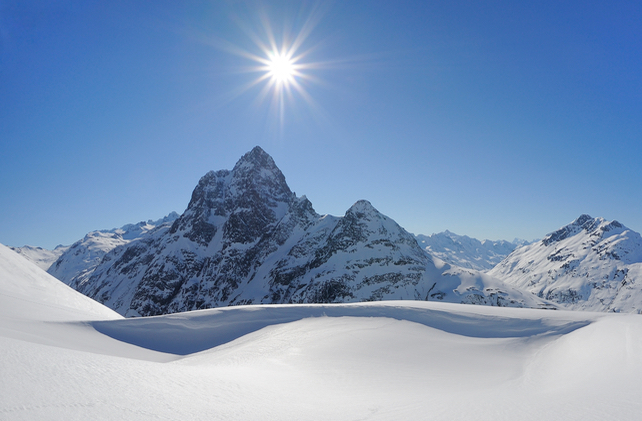
A Short Guide to the Skiing in St Anton
It’s not so much the extent of the skiing that distinguishes the Arlberg. With a little more than 300km of waymarked pistes on offer, it’s still no match for the Three Valleys in France. It’s the almost infinite variety of terrain that marks it out. Easy pistes, vertiginous blacks, entry-level off-piste, white-knuckle couloirs – with an Arlberg lift pass in your pocket they’re all on the menu, served up with an ever-changing backdrop of stupendous scenery.
But that doesn’t mean St Anton’s nature has fundamentally changed. This is still primarily a resort for athletic skiers, who like their pistes steep and aspire to blasting through powder too (if they’re not skiing it already). Yes, the new Flexenbahn link has speeded up access to Lech’s easier slopes. And yes, the cruisy pistes in St Anton’s own Rendl sector are more accessible too, thanks to the repositioning of the lift station. But if you want lots of broad, confidence-boosting pistes on the doorstep you need to target somewhere like Gurgl or Tignes or Val Thorens instead: or stay on the other side of the Arlberg, in Lech-Zurs. Save St Anton for the moment when you start loving bumps, or longing for powder.
Here’s a pre-pandemic promotional video filmed in January 2019, just to give you a taste of how it looks when the snow is soft, cold and fairly fresh. Note how busy some of the pistes are though – even in an “off-peak” month like January. St Anton’s reputation means it’s always buzzing.
https://www.youtube.com/watch?v=VdcNzaBZLWM
We don’t recommend it for beginners
If you’re looking for quiet, unstressful nursery slopes, or miles and miles of intermediate cruising then – of course – there are slopes for you here too. But you’ll be happier elsewhere. In fact, the only reason beginners should target St Anton is if they’re part of a mixed-ability group, or if Mum & Dad are paying.
Lech, on the other side of the Valluga and with its ski area now linked into the village of Warth-Schröcken, would be a better option. Or one of the smaller/cuter/cheaper resorts elsewhere in the Tirol. But if you are going to St Anton, then there’s one simple rule: book a ski school that teaches you on the slopes in the suburb Nasserein, and stay there. For a neophyte, the pitch of most of St Anton’s lower runs is challenging: and on a busy day, when the pistes are bumpy, and more experienced skiers are powering back into the resort, skiing them can be a confidence-shattering experience. If you do want to see some of the rest of the resort, go to the easy blues at Rendl at the end of the week.
Plenty of resorts will suit the intermediate better
There is some fine on-piste skiing here, although you’d do best to save St Anton for the moment when you’re ready to leave the groomed snow for powder. But if you are fixed on St A, then follow these simple rules:
1. At the start of the week, avoid the slopes from Gampen down to the bottom of the Galzig/Gampen lifts unless absolutely necessary. They’re almost always busy, and their lowish altitude and sunny aspect mean the snow can soften quickly and be worn into bumps. The only time you want to ski them (slowly, watching out for the occasional nutter) is on the way down to the Mooserwirt for some apres-ski. Warm up first on the uncrowded slopes around, and en route, to the village of Stuben, or over in the separate Rendl sector. Always stick to the blues. A red in St Anton could well be a black in the last resort you visited.
2. Once you’ve got the measure of those, you can ski over to neighbouring Lech and Zurs where you’ll a greater proportion of confidence-boosting pistes. When you’re really on form, set yourself against the reds off the Schindler Spitze, which offer over 1000m of vertical descent.
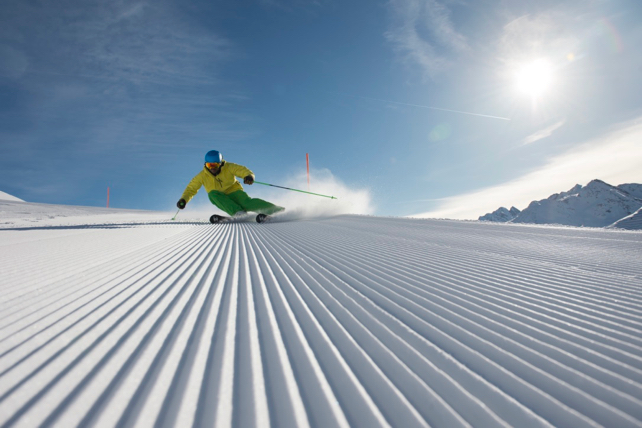
Advanced skiers and snowboarders will love this place
This is when St Anton gets really interesting. First of all, if you’ve come to experiment with off-piste skiing, then you’ll have a ball: especially if you sign up with Piste to Powder. It has been guiding skiers through their first powder turns for years.
And if all you want to do is ski fast and hard on bumps and piste, then you’ll find some scorchers here too: notably the reds off the Schindler Spitze, the World Cup Fang race course from Kappall into St Anton, and the run off the top of the Kappall chair down into the Mattun valley – it is almost always home to monstrous bumps.
Don’t write off neighbouring Lech and Zurs. Yes, they have an intermediate-friendly reputation, but they’re also home to the finest fall-line piste in the Arlberg area – the breath-takingly steep Langerzug. It’s marked 215 on the piste map and is classed as an Extreme Skiing Route – so it’s not always groomed (check the morning piste report to be sure). But when it is, and the snow is soft, it’s a superb straight-down-the-mountain descent.
Bear in mind that Lech and Zurs almost always get more snow than St Anton. Meanwhile Warth am Arlberg, at the far end of the lift system, is the snowiest resort in the Alps. So consider a day off-piste in one or both, with Alpin Center if the backcountry in St Anton feels crowded.
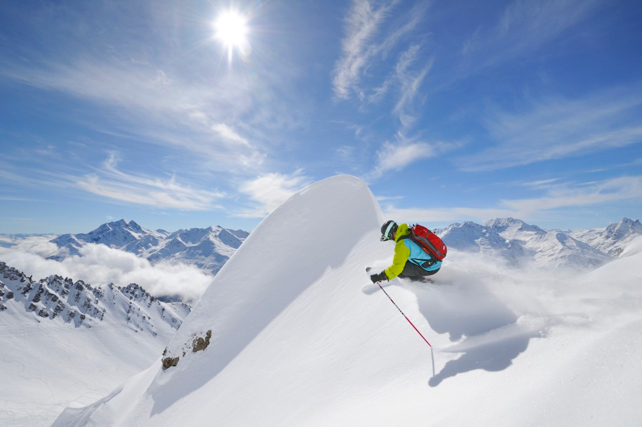
The north face of the Valluga is a must-ski mountain for experts
If you’re a proper off-pister you need to ski this at least once in a lifetime: and it’s not technically very difficult, compared with, say, the bad bits off Verbier’s Mont Fort . First you have to take the final cable-car to the top of the 2811m Valluga. What gets the butterflies hatching is that you’re only allowed to board the cabin carrying skis if you are with a qualified guide. Sightseeers look at you with wonder. This changes to awe when you kick off from the viewing platform.
However, assuming you make the first turn – it’s pretty important to make the first left-hander unless you are a base jumper – the rest is technically easy. You need the guide largely because of the considerable avalanche risk. If this run is on your wish list, there are plenty of guides available and we strongly recommend Piste to Powder. Or try the Arlberg Guides. In fact, hiring a guide whenever you venture off-piste is essential for all but the most experienced, capable and level-headed skiers. It’s not just that many slopes here are avalanche-prone. It’s the fact that St Anton’s terrain can seem inscrutable to the uninitiated. You need a qualified local to lead you to its hidden riches.
Where to Stay in St Anton
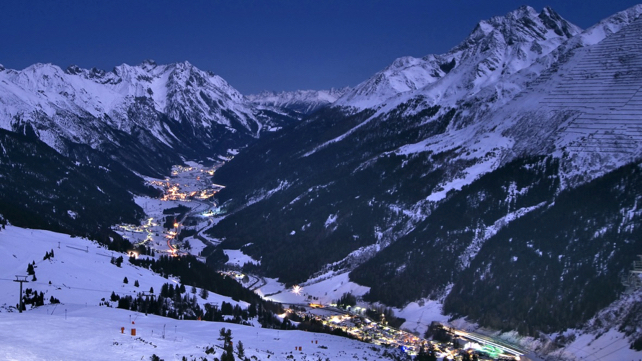
St Anton comes in three main chunks, the town centre (Dorf), Nasserein, and Oberdorf.
The town centre is where you want to be for quick access to the main lifts, as well as the legendary nightlife, and the resort’s excellent indoor pool and climbing wall/bowling centre. Nasserein – 10-15 minutes’ walk from centre of town – is for those who still want good access to St Anton’s skiing (courtesy of the Nassereinbahn gondola), but aren’t so interested in the nightlife. It’s also the best place for beginners and children, because the best nursery slopes in St Anton are right next to the Nassereinbahn.
Meanwhile, Oberdorf, up on a hill above the Dorf, is St Anton’s most tranquil spot. Each morning, there’s a walk downhill to the main hub of lifts and pistes, which can be slippy if there’s compacted snow on the road. So it’s best to leave your ski boots in overnight storage (for example, at Alber Sport) and go down in something with more grip.
One other thing: British skiers who are looking for traditional, catered chalet holidays that come as part of ATOL-bonded, flights inclusive packages will currently find these in very short supply. Most of the British chalet companies have disappeared altogether from the resort, although Skiworld is, at the time of writing, operating five chalets there.
Central St Anton: for lifts, bars and cool hotels
Central St Anton is unsually pretty and well-proportioned – a triumph of careful planning regulations and pedestrianisation. But it can be noisy at night. If you don’t like the sound of someone else’s après-ski, check there isn’t a bar beneath your room. Those who are staying on the Dorfstrasse should bring earplugs, too.
This is the district where most of St Anton’s hotels are concentrated, and there are some stunners amongst them. Come here for comfort and the convenience of being only a couple of minutes from the key lifts, ski hire shops, bars and restaurants. But give yourself a healthy budget. This is some of the most sought-after accommodation in Austria.
M3hotel
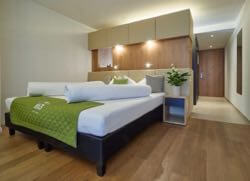
Opened in 2009 by three brothers (Mansuet, Michael and Markus), m3hotel offers four-star minimalism in a tight, town-centre setting. Don’t come here if you’re looking for old-school Tirolean atmosphere or a big spa. But for large bedrooms, clean lines and the sense of having St Anton on your doorstep it’s hard to beat: especially when you’re sitting in rooftop Sky Lounge having breakfast. The en-suite bathrooms are all equipped with infrared cabins and rainforest showers.
Hotel Anton
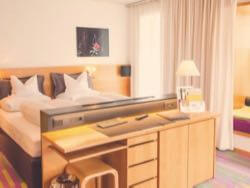
Sharp-edged, low-rise and faced with weathered wooden shingles, the Hotel Anton ruffled a few feathers when it opened in 2002. But now it’s surrounded by copies. No wonder. It manages to look both utterly modern and as old as the hills – and unlike some of its imitators, the atmosphere is as friendly and comfortable as a favourite pair of slippers. Big windows, generous room sizes, and interesting art add to the appeal, as does the groovy rooftop spa – and best of all it’s only a minute’s walk from the lifts up to Galzig and Gampen.
Hotel Himmlhof
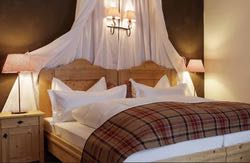
The Himmlhof is our favourite four-star in St Anton. Run with charm and efficiency by Margarita and Sebastian Penz, it’s tucked away down a quiet side-street, and combines crackling fires, flickering candles and rough wood panelling to soothing effect. Yes, the style is quite traditional, but there’s something about the use of texture and bold blocks of colour that’s also modern and self-assured. And they serve a magnificent breakfast too.
Raffl’s St. Antoner Hof
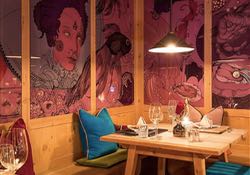
By a considerable margin, this is the Arlberg’s funkiest five-star – a determined attempt to make Tirolean ski hotels contemporary. Think sushi bar, industrial lighting, retro furniture and comic-book murals in the Stubn restaurant. Some will find the decor a bit too busy – but at the very least you should come in for a drink and a bite to eat. Despite the irreverent decor, the Stubn takes its food seriously.
Hotel Alte Post
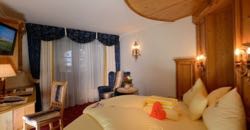
Back in the 17th century, this was The Hotel Alte Poste St Anton’s coaching inn, and it still has the prime spot in the heart of town. It’s a place for those who like their hotels traditional and convenient – along with good food, spacious rooms and painstaking service. Get a room at the back of the hotel if you can, away from the Dorfstrasse. You don’t want a 2am serenade from the après-ski brigade to puncture the hotel’s deep sense of calm.
Ski Schools in St Anton
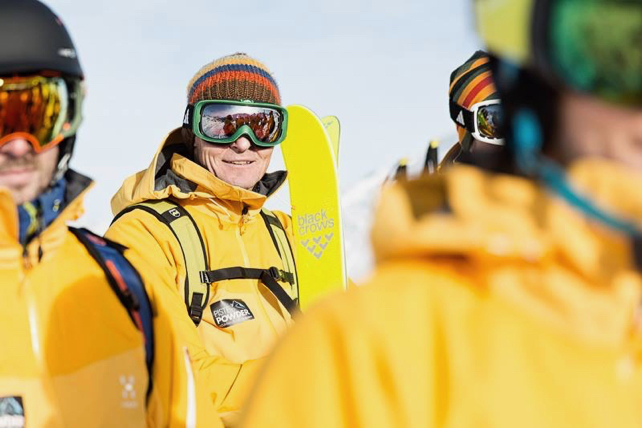
When it comes to ski schools, there’s plenty of choice, starting with the Skischule Arlberg, founded by ski-pioneer Hannes Schneider in 1921. Today, it employs almost 350 instructors and is the largest ski school in Austria. Smaller are Skischule Alpine Faszination, and Ski Akademie St Christoph. There are also 30-odd one-man ski schools, the names of which can be found on the resort website.
A recent addition to the Arlberg scene is the international ski school New Generation – well known in French resorts such as Courchevel and Meribel for its fun-loving style and flexible approach to tuition.
A place of pilgrimage for off-pisters
St Anton is a place of pilgrimage for skiers who want to start skiing off-piste, or fine-tune their powder turns. Teaching them is one of Piste to Powder’s specialities. As well as guiding expert groups, it has recently returned to its roots, offering regular clinics for confident piste skiers who are comfortable on black-rated pistes, but want to progress onto more challenging snow.
If you don’t want tuition, but still want to tackle St Anton’s famous backcountry terrain, then you should hire a guide. Many of the best runs are not obvious – and those that are will be skied into moguls in an instant. Others – such as the top of the north face of the Valluga – are extremely avalanche-prone. You need to play it safe.
There are several options in town. Meanwhile, if you fancy trying the powder over in Lech and Zurs, you’ll need to contact the Alpin Center there.
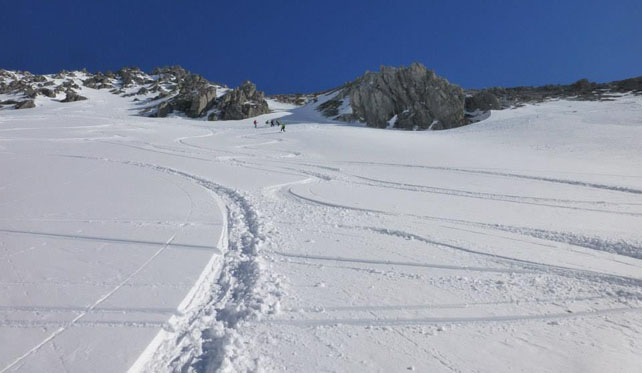
In spite of the hard-core image, there are good facilities for children
Over the years, we’ve heard good reports about the Arlberg Ski School’s children’s lessons. The Kiki Club, operated by the St Anton ski school, runs ski classes for older children.
For the little ones, Kinderwelt is the Arlberg school’s kindergarten, with even the tiniest of skiers accepted here – once they are out of nappies.
The Best Restaurants in St Anton
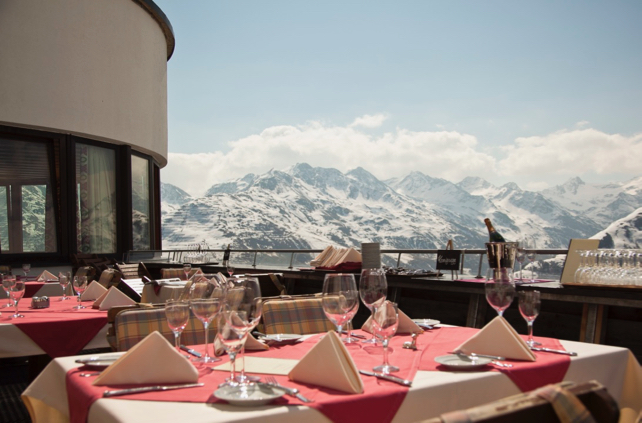
You’d think lunch for most people in St Anton would be stuffed into a rucksack alongside a collapsible shovel and avalanche probe: but actually there’s a burgeoning mountain-restaurant scene here. One of the best is the highly-rated Verwall Stube, which is at the top of the Galzigbahn lift from town. To find it, you need to go through the self-service Kandahar. The atmosphere doesn’t match the best mountain restaurants of Italy, Switzerland and France (one of our editors found himself listening to “I Love Rock and Roll” by Joan Jett & the Blackhearts on the restaurant’s music system recently). But there’s no doubting the quality of the food. Dishes such as a Tirolean trout and char with pickled cucumber and beetroot are both inventive and delicious.
Serious lunchers will also want to ski down to the Arlberg Hospiz-Alm at St Christoph – which has a rustic interior with staff kitted out in Dirndls and leather Lederhosen and serving mountain food like Gulaschsuppe and frankfurters at lunchtime. In the evening the place is transformed into a gourmet restaurant.
Ulmer Hutte, just below the top of the Schindlergrat, is a lovely little place for lunch, offering the best of traditional Tirolean dishes in cosy surroundings. The Rodelalm on the way down to the Nasserein gondola is good value and has a large sun terrace.
Anybody exploring the quieter pistes over towards Stuben should book a table at the low key but gastronomic Fuxbau Restaurant as their reward. Finally, party animals will be delighted to know that the Mooserwirt, on pistes 22 and 23, down from Gampen into town, does good food at lunchtime. You can stop here at 1.30pm, spin out lunch for a couple of hours and – hey presto – you’re in the perfect spot when the DJ gets to work.
The town is a great place to eat and getting better all the time
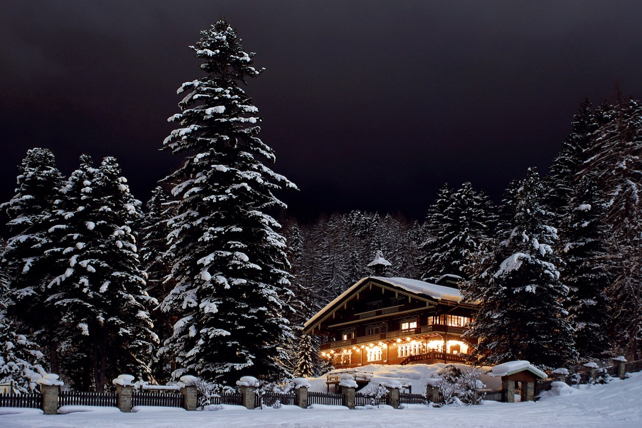
The eateries at the m3hotel include the excellent m3cafe and the m3hazienda restaurant. Another new venue is the Tannenhof, serving local and regional fare. By night the Werner family’s Arlberg Hospiz-Alm, in St Christoph, puts on the tablecloths and becomes a serious gourmet restaurant with an astonishing wine cellar containing some 20,000 bottles – and what is reputed to be the world’s finest private collection of Bordeaux. The Museum is like eating in front of the fire in someone’s home (it was the main setting for the 2011 movie Chalet Girl), and there are interesting displays to look at as well.
Meanwhile, just off the main pedestrianised street, in the middle of town Der Grieswirt does traditional Tirolean grub really well – and at affordable prices. Make sure you start you meal with Stanzertaler Suppen: a clear beef consommé with cheese and bacon dumplings. Nearby, Bodega is a popular tapas bar that gets busy later on in the evening, but stays open until the early hours.
Nasserein’s San Antonio is a popular pizzeria. For a drink and a snack, head to Anton.
Let’s Get This Party Started: Après-Ski in St Anton
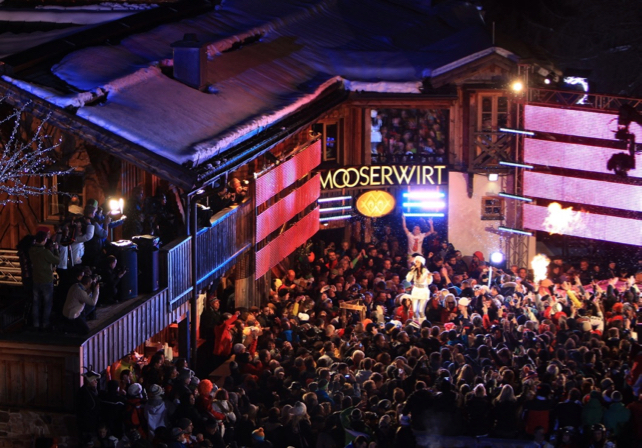
In any normal winter, St Anton is one of the party capitals of the skiing world, and we’re all hoping it gets back into its stride this winter.
When that happens the old rhythm should return – which runs something like this. At 3.30pm report for action at the Krazy Kanguruh, reached by the Gampen chair and piste numbers 22 or 23. Yes, we agree, it’s very early to be taking the skis off – but if you’re any later than this, you won’t get a table. And if you don’t have a table, what are you going to dance on? The famous bar, by the way, is owned by Olympic slalom gold medallist Mario Matt.
But the KK is only the warm-up for the main attraction: the MooserWirt a couple of hundred metres downhill. This has come a long way since it was a cowshed: it is now a boutique hotel as well as a bar with 30km of plastic tubing delivering 5,000 litres of beer a day (and frightening amounts of Gluhwein and Jaegermeister) from the cellars to the bars – fuelling a couple of hours of mayhem, every evening. Before you enter, gather everybody in your group and agree on a place to put your skis that’s well away from the piste and can be easily found when you’re blind drunk. Then get stuck in.
From 8pm the decks at the MooserWirt are turned off and everyone goes home – downhill, on skis, and in the dark. You might want to leave a little early, or stay on to eat in the restaurant, thereby avoiding the carnage.
At 9.30pm phase two of a typical St Anton evening kicks off in town. Murrmel is one of the hottest spots to gather.

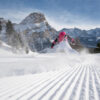
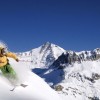
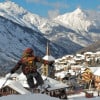
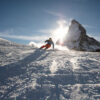
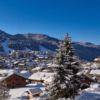

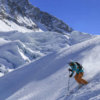
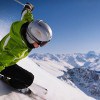
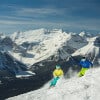
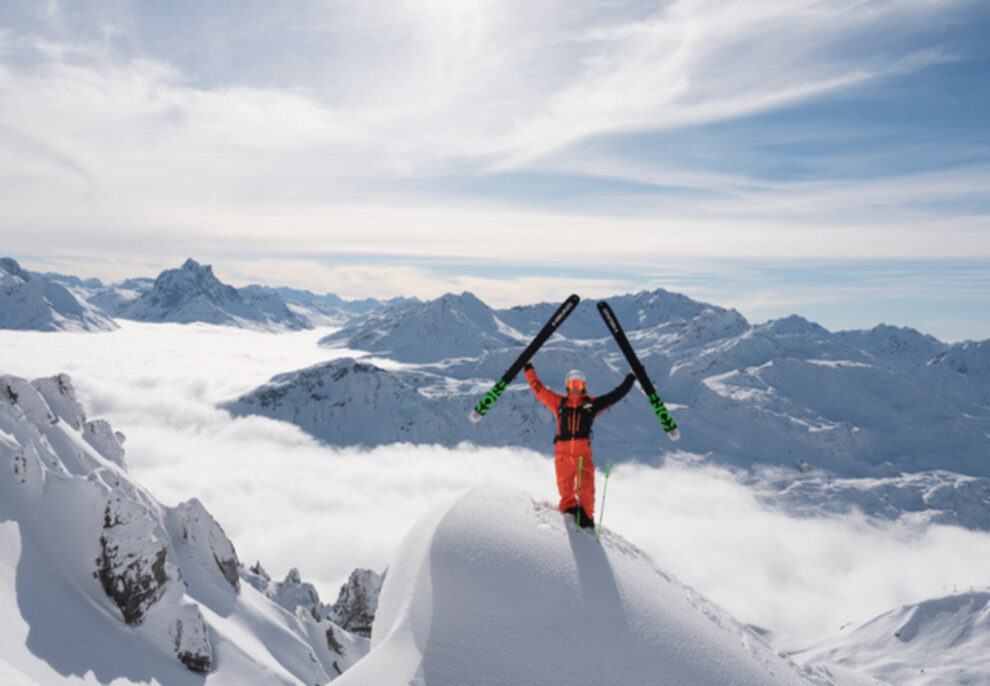
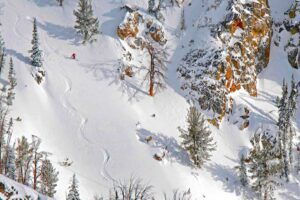
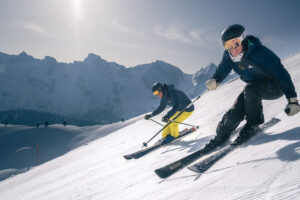
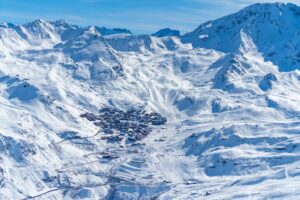
A great article Sean. Superb in formation and very enjoyable.